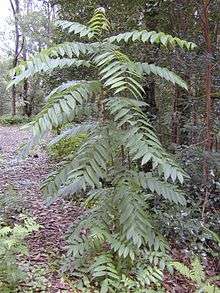Toona ciliata
Toona ciliata is a forest tree in the mahogany family which grows throughout southern Asia from Afghanistan to Papua New Guinea and Australia.[2][3] It is commonly known as the red cedar (a name shared by other trees), toon or toona (also applied to other members of the genus Toona), Australian red cedar,[4] Burma cedar, Indian cedar, Moulmein cedar or the Queensland red cedar. It is also known as Indian mahogany.[5] Indigenous Australian names include Polai in the Illawarra. Woolia on the Richmond River, Mamin & Mugurpul near Brisbane, and Woota at Wide Bay.[6]
| Toona ciliata | |
|---|---|
 | |
| Small specimen of Toona ciliata | |
| Scientific classification | |
| Kingdom: | Plantae |
| Clade: | Tracheophytes |
| Clade: | Angiosperms |
| Clade: | Eudicots |
| Clade: | Rosids |
| Order: | Sapindales |
| Family: | Meliaceae |
| Genus: | Toona |
| Species: | T. ciliata |
| Binomial name | |
| Toona ciliata M. Roem. | |
| Synonyms[1] | |
| |

Description
In Australia, the tree's natural habitat is subtropical forests of New South Wales and Queensland, much of which has been extensively cleared. The Australian population was formerly treated as distinct species under the name Toona australis. The species can grow to around 60 m (200 ft) in height and its trunk can reach 3 m (10 ft) in girth. The largest recorded T. ciliata tree in Australia grew near Nulla Nulla Creek, west of Kempsey, New South Wales and was felled in 1883.[7]
The southernmost limit of natural distribution is on basaltic soils, growing west of the Princes Highway near the village of Termeil, south of Ulladulla, southern Illawarra, New South Wales.[8] It also naturally occurs at Norfolk Island.[9]
It is one of Australia's few native deciduous trees. The timber is red in colour, easy to work and very highly valued. It was used extensively for furniture, wood panelling and construction, including shipbuilding, and was referred to as "red gold" by Australian settlers.[10] Heavily and unsustainably exploited in the 19th and early 20th centuries, almost all the large trees have been cut out and the species is essentially commercially extinct.[11] Availability of this timber is now limited.[12]
Timber is currently also harvested in New Guinea.[13] Although it is not generally a viable plantation species, trees are regularly harvested by Forestry in the Atherton region of Queensland. It grows best in an environment with high light levels, however in the relative darkness of the rainforest understorey, it is less susceptible to attack by the cedar tip moth. The cedar tip moth lays its eggs on the tree's leading shoot, allowing the larvae to burrow into the stem. This causes dieback and a multi-branched tree with little commercial value.[14] The tree exudes a chemical that the female cedar tip moth seeks out. This moth does not attack commercial plantings of Asian/African/Australian native meliaceas in South America. As a result, successful planting of Toona ciliata is being observed in many parts of Brazil, including genetic improvement and clonal production.
Other areas
The red cedar is widely planted in subtropical and tropical parts of the world as a shade tree and for its fast-growing aspect. It is grown in the Hawaiian Islands of the United States, and southern and eastern Africa. In parts of Zimbabwe and South Africa, it has naturalised; growing to maturity and spreading from seed.[15]
Reproduction and dispersal
Toona ciliata reproduces by seed. It is a prolific seed producer and establishes readily.[5]
Gallery
 Toona ciliata - capsules and seeds
Toona ciliata - capsules and seeds Toona ciliata - germinating seeds
Toona ciliata - germinating seeds Toona ciliata - seedlings
Toona ciliata - seedlings- Toona ciliata - red leaves

 Toona ciliata bark, tree near Macksville, New South Wales, Australia
Toona ciliata bark, tree near Macksville, New South Wales, Australia Stand of approximately 10 mature Toona ciliata, south of Drake, New South Wales, a rare sighting in this area
Stand of approximately 10 mature Toona ciliata, south of Drake, New South Wales, a rare sighting in this area

 A stand of Toona ciliata near Kempsey, New South Wales
A stand of Toona ciliata near Kempsey, New South Wales 40-metre Toona ciliata, leafless in August, with epiphytic Dendrobium orchids at Barrington Tops, Australia
40-metre Toona ciliata, leafless in August, with epiphytic Dendrobium orchids at Barrington Tops, Australia Eight-year-old seedling-planted Toona ciliata, Campo Belo, southeast Brazil
Eight-year-old seedling-planted Toona ciliata, Campo Belo, southeast Brazil Four-year-old - 17 meter cloned Toona ciliata, Campo Belo, southeast Brazil
Four-year-old - 17 meter cloned Toona ciliata, Campo Belo, southeast Brazil Clones production Toona ciliata, Campo Belo, southeast Brazil
Clones production Toona ciliata, Campo Belo, southeast Brazil
See also
- Cedar wood
- Macleay River
- Toona sureni
References
- "Toona ciliata M.Roem. — The Plant List". Retrieved 10 June 2017.
- "PlantNET - FloraOnline". Retrieved 4 November 2016.
- "Toona ciliata". Germplasm Resources Information Network (GRIN). Agricultural Research Service (ARS), United States Department of Agriculture (USDA). Retrieved 14 December 2017.
- "Toona ciliata". Natural Resources Conservation Service PLANTS Database. USDA. Retrieved 11 December 2015.
- "Toona ciliata (Toon Tree)". BioNET-EAFRINET. Retrieved January 27, 2015.
- Cedar & the Cedar Getters - James Jervis. Abridged from the J & Proc. of Roy. Austr. Hist. Soc. 25 (2), 1940. Historical Records of New South Wales, Vol.2, page 283. Forestry Commission of New South Wales
- "NSW Wilderness Red Index". Archived from the original on 2009-09-30.
- Eurobodalla Regional Botanic Gardens
- "Red cedar tree in Lindsay Street". Toowoomba Regional Council. Retrieved 2015-01-27.
- "Types of Timber". Time 4 Timber. Archived from the original on 2009-01-20. Retrieved 2009-01-21.
- Vader, John. (1987). Red Cedar. The Tree of Australia’s History. Reed: Sydney. ISBN 0-7301-0151-7
- "Red cedar". DAFF.
- "PNGTreesKey - Toona ciliata". Guide to the Trees of Papua New Guinea. Retrieved 2009-01-21.
- "Australian Red Cedar".
- "Flora of Zimbabwe".
